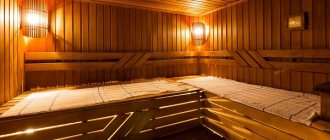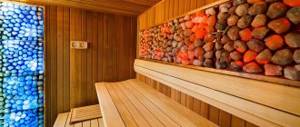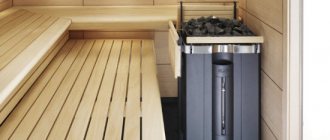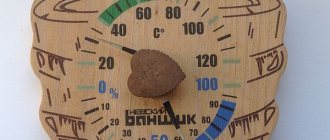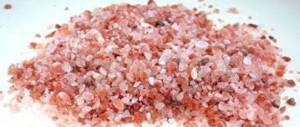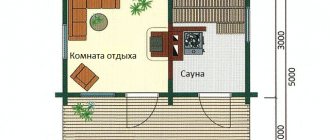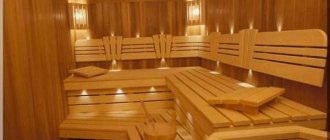From time immemorial, people have visited, and will continue to visit, bathhouses and saunas in their classical form, in order not only to cleanse the body, but also to relax the soul. Inventors from Japan, who relatively recently developed infrared saunas, could not help but take advantage of this popular love for health procedures.
Infrared sauna
All manufacturers of IR saunas or IR cabins claim the low energy consumption of these devices, ease of use, as well as complete safety, including for health. On advertising brochures there are lines in large letters stating that there are no contraindications for visiting saunas, but you should not blindly trust everything that entrepreneurs who do not particularly care about their customers are trying to sell.
Infrared cabin
Procedures in the IR cabin
An infrared sauna is not contraindicated for children
Let's consider the principle of operation of IR cabins, as well as their varieties, in order to more accurately learn about the benefits of the procedure and possible contraindications.
Sauna microclimate
The sauna is hot, it is heated by hot air, and the temperature in it can exceed 100 degrees Celsius. At the same time, the humidity in the room is low.
Inside the sauna is equipped with stepped benches at different heights, so the temperature difference can be from 60 to 90 degrees Celsius.
The gold standard for temperature conditions in a sauna are the following parameters:
- At a distance of one meter from the stove and at a height of one and a half meters from the floor, the air temperature should not be lower than 85 degrees Celsius with a relative humidity of no more than 15%.
- Air temperatures near the ceiling can exceed 110 degrees Celsius.
- The absolute humidity parameters in the sauna should be from 40 to 60 grams of water per cubic meter of air.
- The temperature of the floor should not be lower than 40 degrees.
Features of the Finnish sauna
The steam room is a room completely covered with wood. It is equipped with wooden shelves-beds, which are placed along the walls in 2-4 rows. On the lower levels, bath procedures are taken while sitting, on the upper ones - lying down.
The increase in air temperature occurs due to stones heated by an open-type electric or wood-burning stove. You should not water them to avoid increasing humidity in the steam room. Many people like to apply a few drops of essential oils of medicinal herbs to stones to enhance the relaxing and healing effect.
Smoke is exhausted through chimneys, which are installed without fail for safety.
But the main distinguishing feature of the Finnish sauna is dry steam, which is maintained by low air humidity (15-20%). The temperature stays between 70-100°C, but can warm up to 140-160°C. Despite this, it is easily tolerated due to dry air. Therefore, people who cannot withstand the humidity of a Russian bath can safely visit a Finnish sauna.
These conditions contribute to good warming of the body and rapid sweating, and as you know, toxins are removed from the body along with sweat. After 10-15 minutes, you need to plunge into cool water in a pool or natural pond. Due to this, sweat is washed off and the body cools down - the body is cleansed and hardened.
Why is it easier to breathe in a sauna?
All living organisms need light, negatively charged ions found in fresh air. Without them, all living things grow old, get sick and die.
Ions with a minus sign predominate in the mountains, coniferous forests, and on the sea coast.
Enclosed spaces contain practically no negative ions; they give up their charge to the walls of the building and grounded structures. Therefore, positive heavy ions are formed in closed, crowded rooms.
In a closed room it is not comfortable, stuffy and difficult to breathe. Research was conducted that revealed an amazing fact.
At the same temperature, there are more negative ions in the sauna, and positive ions in the bathhouse.
Oxygen deficiency is compensated by an increased concentration of negative ions.
A Russian bath with wet clouds of steam can only envy the sauna with its unique ease of breathing.
What is the difference between a Finnish sauna and a Russian bath?
In terms of their therapeutic effect and structure, the Russian bathhouse and the Finnish sauna are similar: they use wood for their construction, have a steam room, heater stoves, and a place for washing and relaxing. After bathing procedures, people cool off in a pond, font or shower. What is their difference?
1. First of all, they differ in microclimate. As mentioned above, in a Finnish sauna the air temperature is maintained in the range of 70-100°C and the humidity is 10-15%. In a Russian bath at a temperature of 80°C, the humidity reaches about 70%. Therefore, the first one is easier to tolerate.
2. Brooms are not used for bathing procedures in the Finnish steam room, since the air in it is dry, and this can lead to skin burns.
3. They also differ in the way they are fired. In a Russian bath, a closed stove is used to heat the air, in which stones are placed. This way the heat in the steam room is retained much longer. Most often the stove is made of brick. The stones are doused with water to increase steam.
Finnish stoves are made of heat-resistant and durable metals. They have open ventilated heaters. During the procedures, you should not water the stones, so as not to upset the balance between temperature and humidity.
4. There is no pool in the Russian bathhouse. For cooling, a cold water font, pond or snow (in winter) is used.
The effect of a sauna on the body
The effect of a sauna is based on thermotherapy, when a temporary increase in body temperature occurs (hyperthermia).
Hyperthermia enhances the body's metabolism and excretory processes.
The periodic effect of heat stimulates thermoregulation and maintains the constancy of the body's water-salt balance.
The sauna, like the bathhouse, is often called the healer of the human body. A Finnish proverb speaks of the sauna as a medicine for the poor.
Constant thermal procedures, alternating heat and cold, heat and moisture, include internal processes in the body. The body begins to work harmoniously, itself coordinating the competent work of internal organs and systems.
A one-time visit to the sauna, non-compliance with certain rules of conduct in it, and uncontrolled time spent in it will not bring any benefit. In this case, there can be no talk about the therapeutic effect of the sauna.
Finnish sauna: harm and benefit. Construction of a Finnish sauna
Many nations have their own culture of visiting the bath complex. Those who are interested in their exotic varieties should pay attention to such an option as the Finnish sauna. If you want to build this complex, you should first become familiar with its features and construction technology.
What is a Finnish sauna
The construction of a bathhouse in Finland has always been considered the sacred duty of every owner. She gave me a good mood and well-being.
The peculiarity of Finnish saunas is that the air is heated to 140 degrees and the humidity level is low (only 5-15%). This makes it easier to tolerate high temperatures.
The Finnish sauna does not allow splashing of water on the stones. Otherwise, the resulting steam will be harmful to health at such high temperatures.
When constructing Finnish saunas, electric stoves, heaters are used, and sometimes infrared heaters are used.
The walls of the steam room are necessarily covered with wood, and essential oils are used during the procedures.
The complex of these relaxes a person and restores his vital energy.
Construction of a sauna
Recently, it has become very popular to build bath complexes in your home and even in apartments. Each type of home uses its own version of this room.
As for the Finns themselves, in their country there are 2 million saunas for a population of 5 million. They are built in apartments and basements of multi-family houses.
In our country, this type of bathhouse is also quite in demand.
The construction of Finnish saunas should be made from high-quality materials. This will not only extend the service life of the complex, but will also have a beneficial effect on human health and well-being. Poor quality building materials, on the contrary, will harm people in the bathhouse.
Due to the high cost of constructing a Finnish sauna project with the participation of construction companies, many decide to create it themselves.
Having studied the technology of the process, anyone can create such a miracle as a Finnish sauna or bathhouse.
Sauna materials
In order for the bathhouse to serve the benefit of its owners for a long time, you should choose high-quality building materials.
Finnish sauna designs allow the use of a wide variety of materials:
- wood (boards, logs, beams);
- cement, sand, clay;
- brick, stone;
- insulating materials;
- glass;
- pipes and other communications;
- roof.
The main properties that a bath material should have are high strength, good heat and vapor barrier qualities.
Therefore, wood is ideal for a Finnish sauna. Rocks that do not release resins when heated are used. Such requirements also apply to wood used for the construction of shelves in the steam room.
Resins released when heated can cause burns if they come into contact with the skin. It is better to use hardwood.
The construction of Finnish saunas also involves choosing special glass for the door. This material does not require special care and meets all the requirements of a steam room.
Glass for sauna doors retains heat well and is resistant to high temperatures and splashes of water from the steam room. The variety of shades of this material available allows you to create the most suitable image of the room.
The lighting in the bathhouse should be dim. Therefore, special shades for lamps should be used. They can also be made of wood.
When selecting the necessary building materials for the construction and decoration of a sauna, it is necessary to maintain the integrity of the image of the complex. It should be relaxing, relaxing.
Initial stage of construction
When constructing a bathhouse yourself, you must adhere to a clear sequence. Compliance with technology serves as the basis for the proper functioning of such a complex as a Finnish sauna. A bathhouse built incorrectly will cause discomfort to its visitors from the very first minutes, and the healing effect will be reduced to zero.
Even the little things matter. The construction procedure is carried out according to a certain scheme.
Initially, the floor of the steam room is arranged. It is allowed to use wood for this. However, this is not the best material for a sauna floor. It cannot be varnished. And without treatment, the durability of wood in humid conditions is reduced.
The best flooring for a bathhouse is tile. It will be durable and practical, as well as meeting all sanitary and hygienic requirements.
After this, the frame is assembled.
The box is installed according to the diagram calculated in accordance with the dimensions of the bathhouse. To do this, use wooden combs, nylon dowels, and screws.
The ceiling frame is assembled by connecting timber.
A place is provided for installing doors.
Main stage of construction
The high humidity and temperature of a Finnish sauna have an aggressive effect on the wiring. Its installation is carried out in accordance with enhanced safety measures. For this purpose, heat-resistant wiring with double insulating material is used.
Next, thermal insulation is installed on the frame. If the material chosen for these purposes does not have foil, it must be attached independently. It will create a “thermos effect” in the steam room.
After this, the lathing is done in increments of 40 cm.
Next, the frames for the benches are installed. They are mounted horizontally.
Next, the upholstery is installed. Ventilation is provided above the stove.
For external installation, ordinary steel nails are used. Inside, a Finnish sauna involves the use of special profiles that will prevent the boards from coming apart in the future. You can fasten them with ordinary metal nails to the tongue, but their heads must be covered with a comb.
Sauna arrangement
Much attention is paid to the sauna heater. This is her heart. The stones in the stove should be round and smooth, which will ensure proper air circulation in the room.
The steam room must be equipped with ventilation, which consists of an exhaust and supply opening with valves.
A sauna is indispensable without a thermometer to control the temperature and a hydrometer to measure the humidity level.
You should also provide hours for observing the regime of staying in the steam room.
Infrared sauna
It is difficult to classify this type of sauna as a bathhouse. This is just a small cabin that is used for relaxation and healing of the body.
If the space in the house does not allow the construction of an entire steam room complex, an infrared sauna will be the solution. The Finnish bath differs from it in the principle of creating heat. In the first option, the air temperature is relatively low, since the principle of “solar heat” operates. The infrared energy elements of a Finnish sauna heat objects, but not the air. Like the sun in spring.
The classic temperature regime of a Finnish sauna also heats the air.
Thanks to its use, even the deep levels of the dermis are warmed up, which affects the body. This is how the healing effect of this type of sauna is produced.
Sauna harm
There are certain contraindications for visiting the bathhouse.
Being a health complex, Finnish saunas can cause harm to health if used incorrectly.
If a person has chronic or severe illnesses, you should consult a doctor about the advisability of visiting a steam room.
The harm of a Finnish sauna will be noticeable for people with diseases such as tuberculosis, atherosclerosis, diabetes mellitus, urolithiasis, and nervous disorders.
A bathhouse will also cause harm if the rules for visiting it are not followed. While in the steam room, you need to protect your head with a scarf or a special hat. The benches should be covered with your own sheet.
Each person's body has individual characteristics. The effect of the sauna on it is also unique. There are cases where regular visits to the steam room helped cure even the most serious illnesses.
You should experiment with your own well-being under the strict supervision of a doctor, having contraindications to such procedures.
The benefits of a sauna
The well-known positive effect of the Finnish sauna is to cleanse the skin and subcutaneous layers of dirt and toxins through profuse sweating. Deep stains are not easy to remove with regular washing.
The benefits of the Finnish sauna are relevant for people who suffer from colds frequently and for a long time. With regular visits to the steam room, the immune system is strengthened, prevention and treatment occurs in the initial stages of infectious diseases of the respiratory tract.
Thanks to the sauna, you can lose extra pounds of weight. Skin condition improves.
The dry heat of a Finnish sauna is useful for cardiovascular diseases in moderate stages, liver diseases and skin diseases.
The benefits of a sauna, when visited competently and responsibly, are to improve well-being, as well as restore the energy and metabolic balance of the body.
The harmony of physical and mental state that a Finnish sauna gives a person helps to cope with adverse environmental influences, relieve stress and cleanse the body.
A properly built sauna will last long enough and be fruitful for the health benefits of its owners.
Source: https://1skidka.com/page.php?id=16048
Exposure periods
In the process of taking sauna procedures, there are three main periods.
Each period is determined by the adaptive reserves of the human body and the physical impact of the sauna microclimate during the procedure.
Adaptation
This is passive heating of the body through the lungs and skin.
The body accumulates heat, and the surface layers of tissues warm up. As it warms up, the temperature of the blood and deep layers of tissue increases, and the filling of blood vessels in the muscles and skin increases.
As body temperature rises, sweating begins, and the rate of deep tissue heating and heat accumulation slows down. The adaptation period ends when the temperature of the internal organs reaches 38 degrees or more.
Intense and deep heating of the body
As the body continues to warm up and additional heat accumulates, profuse sweating begins.
Dehydration of the body (dehydration) leads to the loss of not only fluid, but also salts, potassium, and chlorides. This leads to a shift in the salt balance of the body.
The internal body temperature rises to 39 degrees, the body overheats and heat exhaustion occurs. The person feels weak, tired, and cramps appear.
Continued exposure to high temperatures can cause nausea, dizziness, shortness of breath, and inappropriate behavior. These are all symptoms of heatstroke.
In order to feel good in the sauna and not harm yourself and your body, you need to dose the thermal load. You need to realistically assess your capabilities and take into account constitutional features.
Each of us tolerates high temperatures differently. For optimal heat exposure, you can choose a shelf at different heights.
Exit from a hyperthermic state
This is cooling the body.
To ensure that the changes that occur in our body associated with the temperature contrast do not cause negative reactions, an adequate cooling technique is necessary.
You should pay attention to the constitutional characteristics of each person. Obese, overweight people cool down more slowly than tall, slender, thin people.
Adequate cooling involves replenishing fluid lost through sweating and essential microelements.
A deficiency of fluid and mineral salts affects a person’s well-being. Their deficiency leads to lethargy, general malaise, heaviness in the head, and pain in the calf muscles when walking.
Excessive and prolonged hypothermia after a hot sauna can lead to colds.
How to visit a Finnish sauna. Visiting rules
✔ Before entering the steam room, take a shower and then dry your body with a towel.
✔ Since the temperature is high, the sunbeds become very hot. To avoid getting burned or burned, place a towel over them.
✔ While in the steam room, it is best to lie down, before leaving (3 minutes before) - sit.
✔ The duration of the first procedure is maximum 15 minutes. Then the time can be gradually increased. The total number of visits should not exceed 6 times.
✔ After the steam room, cool off in the pool or take a cold shower.
✔ To maintain water balance, drink still water and herbal remedies. You should not drink alcoholic beverages.
If you follow all the rules for visiting a Finnish sauna, you will receive great benefits for your body: strengthen your immune system, protect yourself from viral diseases, lift your spirits, relax, recover after a hard day and recharge your batteries.
Source https://bestlavka.ru/polza-i-vred-finskoj-sauny/
October 13, 2020, The article is located in the sections: Bathhouse, Latest updates
Since ancient times, washing the body has been associated with entire rituals and ceremonies. Each nation sought to create a unique relaxation procedure. The main characteristics of the perception of the bathing process were the benefits of the procedure in general and its healing properties in particular. The mentality of the people and the climatic conditions of their residence played a huge role in the creation of baths. Turkish hammams are distinguished by gentle temperature conditions of 40-45ºС and high air humidity of 80-90%, a Russian bath has an average of 50-70ºС and a humidity of 50-70%, and in the Finnish sauna extreme temperatures of 80 - 110ºС are used with a minimum humidity of 15-20%. Each of these procedures is useful in its own way, each has side effects.
Therefore, the owner must decide whether to build a Finnish sauna, a Russian bath or a Turkish hammam with his own hands, based on personal preferences and medical indications.
The Russian bathhouse and the Finnish sauna are slightly similar to each other visually. Both are covered with wood and the parkas use a broom in the process. This is where the similarities end. You can learn more about the differences from this article.
The Finnish sauna has many useful qualities, you just need to know them.
Indications for visiting the sauna for medicinal purposes
The sauna is not a panacea for diseases. A room with high temperature and low humidity cannot be a universal remedy for all diseases.
You can use the sauna as a preventive or therapeutic method only after consulting a doctor. Only a specialist can determine and assess the nature and stage of the disease, and determine the risks of adverse reactions.
The therapeutic effect of a sauna lies in the competent use of thermal and contrast procedures, these are:
- Duration of stay in the sauna.
- Height of the shelf in the steam room.
- Adequate cooling: outdoors, dousing with water, swimming in a pool.
Baths and saunas are indicated for the treatment of many diseases.
The sauna is beneficial in the final stages of an illness, to restore health, ability to work and the functional state of the body.
Sauna effects
While in the sweat room, the patient experiences the effects on his body of thermal radiation from a heat source, heated walls and ceiling, plus hot air of low humidity. To increase air movement in the sauna, use special brooms made from branches and leaves of birch, oak or other plants. In addition, when quilting the skin with such a broom, the blood flow in it significantly increases. Also, in order to increase the flow of absorbed heat, a so-called steam boost is created - they simply water the heater stones with cold fresh water. As a result of the subsequent evaporation in the sweat room, both temperature and humidity increase for some time.
The thermal factor at low absolute and relative air humidity causes a spasm of blood vessels in the skin and subcutaneous fatty tissue, which after a short time is replaced by their expansion, as a result, blood flow increases 3-5 times. These changes are carried out due to the accelerated synthesis under sauna conditions of mediators - local regulators of blood flow - bradykinin, histamine and prostaglandins.
Intense centripetal flows of impulses from skin structures sensitive to high temperatures activate thermosensitive nerve cells of the hypothalamus, in which centrifugal flows of impulses are formed and spread along the fibers of the autonomic nervous system to the sweat glands. As a result of these processes, sweating and evaporation from the skin surface significantly increases. During a steam boost, due to increased humidity, the intensity of sweat evaporation decreases.
As the air temperature in the sweat room increases, sweating increases proportionally, the volume of sweat varies from 200 ml to 2 liters. Superficial tissues heat up to 40-42°C, and the temperature of internal organs increases by 1°C. The temperature quickly normalizes as the body cools, and the amount of fluid lost in sweat is replenished within several days.
Activation of the central temperature-sensitive nerve cells of the hypothalamus under conditions of elevated temperature leads to an increase in the frequency of heart contractions, which steadily progresses, especially when the patient is on the upper shelves of the sweat room and in an upright position. Diastolic (“lower”) blood pressure and blood flow velocity tend to decrease, which contributes to the expansion of the coronary vessels of the heart and increased contractility.
The hot sauna air inhaled by the patient stimulates the dilation of the bronchi, a decrease in the secretion of their mucous secretions, a decrease in the resistance of lung tissue, and an increase in the rate of gas exchange in their distal parts - the alveoli. Intense evaporation of sweat from the surface of the tracheobronchial tree leads to an improvement in its patency, which entails an increase in the depth and frequency (up to 22-24 per minute) of breathing.
The effect of a steam bath on the neurons of the posterior hypothalamus leads to activation of the sympathetic nervous system and increased synthesis of some pituitary hormones, in particular adrenocorticotropic, somatotropic, luteotropic and others. As a result of these changes, attacks of bronchial asthma are eliminated and immunity disorders in rheumatological diseases are weakened.
The high temperature of the sweat helps to activate the processes of basal metabolism (by a quarter) and tissue respiration (up to 2 times), accelerate the absorption of oxygen by tissues by 30-60% and the processes of excretion of catecholamines in the urine.
Unfortunately, the sauna does not affect the level of lipids in the blood, which means it does not slow down the formation of atherosclerotic plaques and does not reduce the risk of developing myocardial ischemia.
As part of intensely secreted sweat, the body loses urea, ketone bodies, creatine, potassium, sodium, chlorine, magnesium ions, and some amino acids. For this reason, he experiences dehydration. A deficiency of intercellular fluid causes an increase in blood hematocrit, the level of leukocytes, platelets, and a decrease in pH. The fibrinolytic activity of the blood is significantly reduced.
The release of protein metabolic products through sweat has a beneficial effect on the kidneys, reducing the load on them. As a result of a decrease in the processes of filtration and reabsorption (reabsorption) in the glomeruli of the kidneys, the amount of urine excreted by the patient decreases - diuresis.
Lymph drainage and blood flow in the venules are activated, which leads to an increase in skin turgor and elasticity, a decrease in swelling and pastiness of tissues.
The following effects are associated with immersing the patient in water after the heating procedure. At the same time, norepinephrine is released and the skin vessels reflexively narrow. An increase in blood pressure, cardiac output and an increase in oxygen consumption by the heart muscle are also determined. Spasm of the coronary vessels of the heart can cause an attack of angina pectoris in predisposed patients. Ventilation of the lungs in cold water increases, and the respiratory rate and carbon dioxide tension in the blood decrease. The lumen of the bronchi narrows, this can cause an attack of bronchial asthma in a predisposed patient.
Being in a sauna involves alternating exposure of the sick body to hot air and cold water. These procedures stimulate the functioning of the main systems of the body - respiratory and cardiovascular. As a result, blood pressure stabilizes and heart rate decreases. Thermoregulation improves.
10-15 dry air bath procedures lasting 1.5-2 hours each, carried out once a week, reduce fatigue, cause positive motivation, relax muscles, create a feeling of vigor, and form a person’s sustainable adaptation to damaging environmental factors.
Summarizing the above, it is worth noting the following therapeutic effects of the sauna:
- vasoactive (effects on blood vessels);
- thermoadaptive (increasing the body’s resistance to the effects of temperature factors);
- diaphoretic (stimulation of sweating);
- psychorelaxing (I think the term does not need to be deciphered);
- metabolic (acceleration of metabolic processes);
- trophic (improving blood and lymph flow);
- secretory (stimulation of the synthesis of many hormones);
- dehydrating (removing excess fluid from the body).
General indications for visiting a sauna for medicinal purposes
The sauna also has a healing effect; it is indicated for the treatment of the following ailments:
- Chronic colds.
- Chronic respiratory diseases.
- Autonomic disorders of the cardiovascular system.
- Obesity.
- Chronic inflammatory diseases of the musculoskeletal system.
- Chronic diseases of the genitourinary organs.
- Chronic skin diseases.
- Ovarian dysfunction and sterility in women, climatic syndrome.
The effect of the sauna on the body is multifaceted; information about its properties was obtained by observing healthy people, but it also has contraindications.
Indications and contraindications for dry air baths
Visiting the sauna is good for health, but there are also contraindications to this procedure.
The effect of sauna healing factors on the body is beneficial for the following diseases:
- essential hypertension (hypertension) stage 1;
- vegetative-vascular dystonia;
- tracheitis, bronchitis;
- arthrosis;
- osteoarthritis;
- glenohumeral periarthritis;
- increased muscle tone;
- neuroses;
- urinary incontinence (enuresis);
- vertebrogenic radiculopathies;
- paralysis (only mild);
- rheumatic disease in an inactive form;
- obesity;
- chronic hepatitis;
- biliary dyskinesia;
- chronic glomerulonephritis in the stage of stable remission;
- urolithiasis with small diameter stones;
- cystitis;
- dermatitis;
- psoriasis;
- eczema;
- neurodermatitis.
In some cases, a sauna will not bring benefit to the patient, and may even cause harm. Such diseases are contraindications:
- acute infectious and non-infectious inflammatory processes of any localization;
- chronic heart failure stage I-II;
- angina pectoris above functional class II;
- pulmonary heart;
- myocarditis;
- endocarditis;
- pericarditis;
- mitral valve stenosis;
- essential hypertension stages II and III;
- hyperfunction of the thyroid gland;
- diabetes;
- climacteric disorders;
- chronic kidney disease;
- glaucoma;
- decompensated autonomic disorders;
- psychopathy and psychosis;
- pregnancy;
- The patient's age is over 60 years.
Contraindications
- Hypertension.
- Urolithiasis disease.
- Acute diseases accompanied by increased body temperature.
- The final stage of progression of chronic diseases.
- Atherosclerosis.
- Parasitic diseases.
- Tuberculosis.
- Glaucoma.
- Epilepsy.
- Psychoses and psychopathy.
The positive effect of the sauna lies not only in the treatment method. I am sure that its main effect is mental relaxation, relaxation of the body.
Peace, unhurriedness, warmth, and the bliss of the cool water of the pool helps us relax and unwind. Going to the sauna is an excellent way to combat stress and depression. It helps relieve tension, and after the procedure you feel a surge of strength and vigor.
Try it - you will love going to the sauna!
Some rules for visiting a Finnish sauna
In order for a trip to the Finnish sauna to be extremely beneficial, you need to adhere to a number of certain rules. First you need to take a shower and wipe your entire body dry. After you enter the steam room itself, you need to at least roughly measure the time, since it is not recommended to stay in the bathhouse for a long time. The first entry time should not exceed five minutes. It is very important not to forget to remove various jewelry and other accessories. You need to take a towel and a hat to the bathhouse. After visiting the steam room, you must take a swim in a pool or pond. Thanks to this contrast, you can refresh yourself and wash away the sweat.
IR sauna
The duration of a session in an infrared sauna is 30 minutes. You are not allowed to leave the booth during this time. In an infrared sauna, people sit with their back straight and their feet on the floor. To prevent dehydration, drink plenty of water both before and during the procedure. At the end of the session, you can take a warm shower.
The length of infrared waves is equal to the length of heat waves emanating from the human body. As a result, the body easily perceives infrared radiation and does not interfere with its penetration. Under the influence of such waves, the body temperature rises to 38.5ºС, to a temperature sufficient to destroy viruses and bacteria.
The difference in the effectiveness of infrared and other types of saunas is 4 times. An infrared sauna can cause harm. To avoid problems, you need to know when to give it up.
Infrared sauna - its contraindications:
- exacerbation of skin diseases;
- taking medications;
- oncology;
- the presence of tumors, including mastopathy;
- bleeding, including menstruation;
- history of surgical interventions;
- gynecological diseases (endometriosis, fibroids, fibroids, etc.);
- colds, ARVI;
- heart failure;
- tachycardia;
- anemia;
- pressure is both too low and too high;
- joint diseases or inflammation of the joint capsules;
- exacerbation of cystitis or nephritis;
- the presence of any implants.
Bath or sauna
Sauna or steam bath: the benefits and harms of both procedures are approximately similar, but there are also fundamental developments.
Photo: Russian bath - harm or benefit?
The bath is good for colds in the initial stages. A steam room, like a sauna, should not be visited at elevated temperatures or during inflammatory processes. But it’s good to treat in a bathhouse:
- bronchitis;
- laryngitis;
- myositis;
- chronic runny nose;
- arthritis;
- radiculitis;
- neurological disorders.
The harm of a Russian bath will appear when:
- acute inflammatory processes;
- hypertension;
- diseases of the cardiovascular system, including circulatory disorders and heart failure.
High temperatures in steam rooms lead to temporary loss of reproductive function in men due to the death of sperm. To restore it, a few days are enough to update the composition of the seminal fluid.
The value of a bath for women is to speed up metabolism, which promotes weight loss. The steam room improves skin condition. A bath during pregnancy, if you visit it from time to time, will also be beneficial. The procedure will help facilitate labor and reduce its duration by about 30%.
For women, contraindications to the bath are:
- acute inflammatory processes of the genitourinary area;
- postpartum and postoperative periods;
- presence of complications during childbirth;
- oncological diseases.
Having studied the indications and contraindications for baths and saunas, you also need to take into account the main differences in the atmosphere inside steam rooms:
- air humidity in the bathhouse is 40-60%, in a Finnish sauna – up to 15%, in a Turkish sauna – 100%;
- the temperature in the bathhouse is 55-70ºС, in the Finnish sauna – 110ºС, in the hammam – 50-60ºС.
With higher humidity, the body warms up more, and this effect on the cardiovascular system is more significant. Of course, the role of a broom in a steam room cannot be assessed. It increases blood circulation and acts as an aromatherapy agent.
It is impossible to accurately set the temperature in the bathhouse. But in both types of steam rooms you cannot be with wet hair. In this state, they conduct heat well and can cause heat stroke.
Types of saunas
There are 3 types of saunas:
- dry (Finnish);
- wet (Turkish);
- infrared.
The Finnish sauna has a humidity of up to 15% at an average temperature of 90-100ºС. There is hot steam in the steam room, but it is relatively dry inside. Stay in the sauna is limited to 15 minutes. You can make no more than 3 visits in one session. The therapeutic effect is due to sudden changes in temperature, so between visits to the steam room they take a cool shower or dive into a cold pool.
A Turkish sauna (hamam) is 100% humidity at a relatively low temperature of about 60ºС. The steam here is very humid, but not hot. Since the procedure is gentle, you can go to the hammam every day. Since you can often go to such a steam room, the time spent in it should not exceed 15 minutes. Hamam relieves muscle tension well and also effectively relieves insomnia.
The principle of operation of an infrared sauna is based on the fact that the body warms up under the influence of heat waves emitted by heaters. At the same time, the air inside the room remains moderately warm, not from the operation of the equipment, but from the heat given off by objects heated by infrared waves. Air humidity reaches 40-60%, and the temperature is recommended to be set at 35ºС. One session is about 20 minutes.
An infrared sauna, unlike a Finnish sauna, warms the body 5 cm inward. A dry sauna and Russian bath ensure that heat penetrates only 5 mm inside. Accordingly, an infrared sauna stimulates more intense sweating, which promotes faster and better cleansing of the body.
